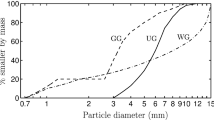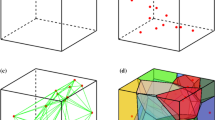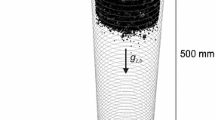Abstract
A computational method is described for the generation of virtual air pores with randomized features in granular materials. The method is based on the creation of a stack of two dimensional stochastically generated domains of packed virtual aggregate particles that are converted to three dimensions and made to intersected with one another. The three dimensional structure that is created is then sampled with an algorithm that detects the void space left between the intersected particles, which corresponds to the air void volume in real materials. This allows the generation of a map of the previously generated three dimensional model that can be used to analyse the topology of the void channels. The isotropy of the samples is here discussed and analysed. The air void size distribution in all the virtual samples generated in this study is described with the Weibull distribution and the goodness of fit is successfully evaluated with the Kolmogorov–Smirnov test. The specific surface of the virtual samples is also successfully compared to that of real samples. The results show that a stochastic approach to the generation of virtual granular materials based only on geometric principles is feasible and provides realistic results.













Similar content being viewed by others
References
Aligizaki, K.K.: Pore Structure of Cement-Based Materials. CRC Press, Boca Raton (2005)
Andrienko, Y.A., Brilliantov, N.V., Krapivsky, P.L.: Pattern formation by growing droplets: the touch-and-stop model of growth. J. Stat. Phys. (1994). doi:10.1007/BF02186870
Baddeley, A.: Spatial Point Processes and Their Applications. http://www.apps.stat.vt.edu/leman/VTCourses/BaddeleyPointProcesses.pdf (2007). Accessed 23 Jun 2015
Chen, J., Huang, B., Chen, F., Shu, X.: Application of discrete element method to superpave gyratory compaction. Road Mater. Pavement Des. 13, 480–500 (2012). doi:10.1080/14680629.2012.694160
Chen, J., Huang, B., Shu, X.: Air-void distribution analysis of asphalt mixture using discrete element method. J. Mater. Civ. Eng. 25, 1375–1385 (2013). doi:10.1061/(ASCE)MT.1943-5533.0000661
Chiarelli, A., Dawson, A.R., García, A.: Generation of virtual asphalt mixture porosity for computational modelling. Powder Technol. (2015). doi:10.1016/j.powtec.2015.01.070
Chiu, S.N., Stoyan, D., Kendall, W.S., Mecke, J.: Stochastic Geometry and Its Applications, 3rd edn. Wiley, New York (2013)
Clauset, A., Shalizi, C.R., Newman, M.E.J.: Power-law distributions in empirical data. SIAM Rev. 51, 661–703 (2009). doi:10.1137/070710111
Feng, H., Pettinari, M., Hofko, B., Stang, H.: Study of the internal mechanical response of an asphalt mixture by 3-D discrete element modeling. Constr. Build. Mater. 77, 187–196 (2015). doi:10.1016/j.conbuildmat.2014.12.022
Hossain, M., Scofield, L.: Porous pavement for control of highway run-off. Arizona Department of Transportation (1991)
Hyman, J.D., Smolarkiewicz, P.K., Winter, C.L.: Heterogeneities of flow in stochastically generated porous media. Phys. Rev. E 85(056), 701 (2012). doi:10.1103/PhysRevE.86.056701
Jiang, F., Tsuji, T.: Changes in pore geometry and relative permeability caused by carbonate precipitation in porous media. Phys. Rev. E 90(053), 306 (2014). doi:10.1103/PhysRevE.90.053306
Kongkitkul, W., Musika, N., Tongnuapad, C., Jongpradist, P., Youwai, S.: Anisotropy in compressive strength and elastic stiffness of normal and polymer-modified asphalts. Soils Found. 54, 94–108 (2014). doi:10.1016/j.sandf.2014.02.002
Kutay, M.E.: Modeling moisture transport in asphalt pavements. Ph.D. thesis, University of Maryland (2005)
Lamond, J.F.: Significance of Tests and Properties of Concrete and Concrete-Making Materials. ASTM International, West Conshohocken (2006)
Last, G., Penrose, M.D.: Percolation and limit theory for the poisson lilypond model. Random Struct. Algorithms 42, 226–249 (2013). doi:10.1002/rsa.20410
Masad, E., Jandhyala, V.K., Dasgupta, N., Somadevan, N., Shashidhar, N.: Characterization of air void distribution in asphalt mixes using X-ray computed tomography. J. Mater. Civ. Eng. 14, 122–129 (2002). doi:10.1061/(ASCE)0899-1561(2002)14:2(122)
Ohser, J., Mücklick, F.: Statistical Analysis of Microstructures in Materials Science. Wiley, New York (2000)
Ohser, J., Schladitz, K.: 3D Images of Materials Structures: Processing and Analysis. Wiley, New York (2009)
Ruiz, A., Alberola, R., Perez, F., Sanchez, B.: Porous asphalt mixtures in Spain. Transportation Research Record No. 1265, Porous Asphalt Pavements: An International Perspective, pp. 87–94 (2002)
Schenker, I., Filser, F.T., Gauckler, L.J.: Stochastic generation of particle structures with controlled degree of heterogeneity. Granul. Matter 12, 437–446 (2010). doi:10.1007/s10035-010-0188-5
Schneider, R., Weil, W.: Stochastic and Integral Geometry (Probability and Its Applications). Springer, New York (2008)
Schöpfer, M.P., Abe, S., Childs, C., Walsh, J.J.: The impact of porosity and crack density on the elasticity, strength and friction of cohesive granular materials: insights from dem modelling. Int. J. Rock Mech. Min. Sci. 46, 250–261 (2009). doi:10.1016/j.ijrmms.2008.03.009
Siena, M., Riva, M., Hyman, J.D., Winter, C.L., Guadagnini, A.: Relationship between pore size and velocity probability distributions in stochastically generated porous media. Phys. Rev. E 89(013), 018 (2014). doi:10.1103/PhysRevE.89.013018
Tashman, L., Masad, E., D’Angelo, J., Bukowski, J., Harman, T.: X-ray tomography to characterize air void distribution in superpave gyratory compacted specimens. Int. J. Pavement Eng. 3, 19–28 (2002). doi:10.1080/10298430290029902a
Thyagarajan, S., Tashman, L., Masad, E., Bayomy, F.: The heterogeneity and mechanical response of hot mix asphalt laboratory specimens. Int. J. Pavement Eng. 11, 107–121 (2010). doi:10.1080/10298430902730521
Vasilyev, L., Raoof, A., Nordbotten, J.M.: Effect of mean network coordination number on dispersivity characteristics. Transp. Porous Media 95, 447–463 (2012). doi:10.1007/s11242-012-0054-5
Younger, K.: Evaluation of Porous Pavements Used in Oregon. http://ir.library.oregonstate.edu/xmlui/handle/1957/35565 (1994). Accessed 21 Jan 2015
Acknowledgments
The authors thank the University of Nottingham for the financial support provided for the Ph.D. of Andrea Chiarelli. The Ph.D. studies of the first author are funded by the University of Nottingham (A. García new lecturer’s award, no grant number).
Author information
Authors and Affiliations
Corresponding author
Rights and permissions
About this article
Cite this article
Chiarelli, A., Dawson, A.R. & García, A. Stochastic generation of virtual air pores in granular materials. Granular Matter 17, 617–627 (2015). https://doi.org/10.1007/s10035-015-0585-x
Received:
Published:
Issue Date:
DOI: https://doi.org/10.1007/s10035-015-0585-x




